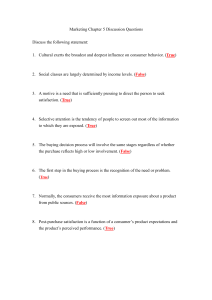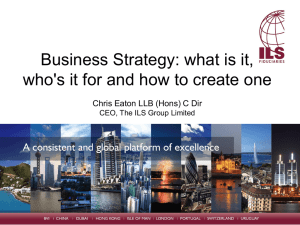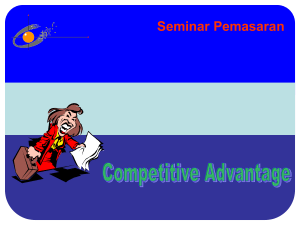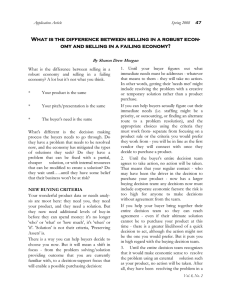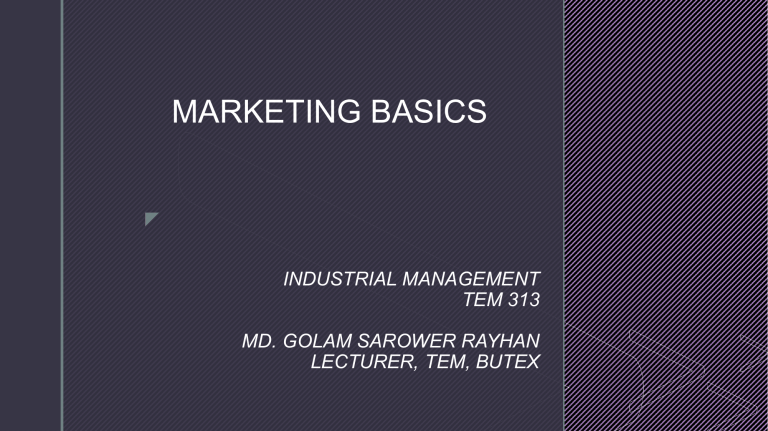
MARKETING BASICS z INDUSTRIAL MANAGEMENT TEM 313 MD. GOLAM SAROWER RAYHAN LECTURER, TEM, BUTEX Market ❑ Collection of all the actual or potential buyers and sellers those are involved in buying and selling is market. ❑ The seller sells goods and services to the buyer in exchange of money. ❑ There has to be more than one buyer and seller for the market to be competitive. ❑ RMG market is comprised of potential foreign buyers (USA, Europe etc.) and local suppliers (factories) for RMG products. Marketing •Marketing is a social and managerial process by which individuals and organizations obtain what they need and want through creating and exchanging value with others. •Marketing is the process by which companies create value for customers and build strong customer relationships in order to capture value from customers in return. Definition of Marketing from Specialists •According to American Marketing Association (2004) - "Marketing is an organizational function and set of processes for creating, communicating and delivering value to customers and for managing relationships in a way that benefits both the organization and the stakeholder.“ •According to Eldridge (1970) - "Marketing is the combination of activities designed to produce profit through ascertaining, creating, stimulating, and satisfying the needs and/or wants of a selected segment of the market." A Simple Marketing System Communication Goods/Services Industry (a collection of sellers) Customer (a collection of buyers) Money Information Nature of Marketing 1. Marketing is an Economic Function 2. Marketing is a Legal Process by which Ownership Transfers 3. Marketing is a System of Interacting Business Activities 4. Marketing is a Managerial function 5. Marketing is a social process 6. Marketing is a philosophy based on consumer orientation and satisfaction 7. Marketing has dual objectives - profit making and consumer satisfaction Scope of Marketing 1. Study of Consumer Wants and Needs 2. Study of Consumer behavior 3. Production planning and development 4. Pricing Policies 5. Distribution 6. Promotion 7. Consumer Satisfaction 8. Marketing Control Customer focus of Marketing • ➢ ➢ ➢ Marketing is used to identify the customer, satisfy the customer, and keep the customer. • The adoption of marketing strategies requires businesses to shift their focus from production to the perceived needs and wants of their customers as the means of staying profitable. Meta Markets • A concept proposed by Mohan Sawhney, describes a cluster of complementary products and services that are closely related in the minds of consumers but are spread across a diverse set of industries. • The automobile meta market consists of automobile manufacturers, new and used car dealers, financing companies, insurance companies, mechanics, spare parts dealers, service shops, auto magazines, classified auto ads in newspapers, and auto websites on the Internet. Marketers vs Prospects • A marketer is someone who is seeking a response (attention, purchase, vote, donation) from another party, called the prospect. • Marketers • Prospects sellers/industries buyers/customers Needs, Wants and Demand • Needs describe basic human requirements such as food, air, water, clothing, and shelter. People also have strong needs for recreation, education, and entertainment. • These needs become wants when they are directed to specific objects that might satisfy the need. An American needs food but wants a hamburger, French fries, and a soft drink. • Demands are wants for specific products backed by an ability to pay. Many people want a Mercedes; only a few are able and willing to buy one. Customer Value • In terms of marketing, the product or offering will be successful if it delivers value to the target buyer. • Value as a ratio between what the customer gets and what he gives. • Value = • • • • • • Functional benefit: technical functioning ability of a product Emotional benefit: psychological satisfaction of a customer Monetary costs: monetary payment done to own a product Time costs: time invested to buy a product Energy costs: energy lost in buying a product Psychic costs: measure the stress of having to think about a transaction Benefits Functional benefits + emotional benefits = Monetary costs + time costs + energy costs + psychic costs Costs Customer Satisfaction Customer satisfaction is dependent on the product’s perceived performance relative to a buyer’s expectations. •If performance is lower than expectations, satisfaction is low. •If performance is higher than expectations, satisfaction is high. Customer satisfaction often leads to consumer loyalty. Some firms seek to DELIGHT customers by exceeding expectations. Marketing Mix/ 4 Ps of Marketing Marketing mix is the set of marketing tools that the firm uses to pursue its marketing objectives in the target market. McCarthy classified these as four broad groups that he called the four Ps of marketing: Product Price Product variety Quality Design Features Brand name Packaging Sizes Services Warranties Returns List price Discounts Allowances Payment period Credit terms Place Channels Coverage Assortments Locations Inventory Transport Promotion Sales promotion Advertising Sales force Public relations Direct marketing 3 Ps of Marketing •People - The individuals involved in the sale and purchase of products or services come under people •Process - Process includes the various mechanisms and procedures which help the product to finally reach its target market •Physical Evidence - With the help of physical evidence, a marketer tries to communicate to get benefits of a product to the end users. 4 Cs of Marketing In the current scenario, the four C’s has thus replaced the four P’s of marketing making it a more customer oriented model. Koichi Shimizu in the year 1973 proposed a four C’s classification. • • • • Commodity - (Replaces Products) Cost - (Replaces Price) Channel - (Replaces Place) Communication - (Replaces Promotion) Robert F. Lauterborn gave a modernized version of the four C’s model in the year 1993. According to him the four C’s of marketing are: • • • • Consumer Cost Convenience Communication Marketing Channels • To deliver Messages to target buyer • Receive Message from target buyer • To display or deliver the physical product or service to the buyer or user. • newspaper, radio, television, mail, telephone, billboards, posters, Internet. • Physical distribution channels • service distribution channels • Dialogue Channel (Email) • Monologue Channel (advertisement) • warehouses, transportation vehicles, and various trade channels such as distributors, wholesalers, and retailers. • to effect transactions with potential buyers • distributors and retailers • banks and insurance companies Market Competition • A company sees its competitors as other companies that offer similar products and services to the same customers at similar prices. • Volkswagen might see its major competitors as Toyota, Honda, and other manufacturers of medium price automobiles, rather than Mercedes or Hyundai. • A company sees its competitors as all companies that make the same product or class of products. • Thus, Volkswagen would be competing against all other car manufacturers. • A company sees its competitors as all companies that manufacture products that supply the same service. • A company sees its competitors as all companies that compete for the same consumer dollars. • Volkswagen would see itself competing against manufacturers of all vehicles, such as motorcycles, bicycles, and trucks. • Volkswagen would see itself competing with companies that sell major consumer valued products, foreign vacations, and new homes. Marketing Environment Task Environment • the immediate actors involved in producing, distributing, and promoting the product/ offering • including the company, suppliers, distributors, dealers, and the target customers. • Also including marketing research agencies, advertising agencies, Web site designers, banking and insurance companies, transportation and telecommunications companies Broad Environment • • • • • • Demographic environment Economic environment Natural environment technological environment political-legal environment social-cultural environment Marketing Process Create value for customers and build customer relationships Understand the marketplace and customer needs and wants Design a customer-driven marketing strategy Construct integrated marketing program To delivers superior value Build profitable relationships and create customer delight Capture value from customers in return Capture value from customers to create profits and customer equity Model of Consumer Behavior Product Marketing and Other Stimuli Economic Price Technological Place Political Promotion Cultural Buyer’s Decision Process Product Choice Brand Choice Dealer Choice Buyer’s Black Box Buyer’s Response Characteristics Affecting Consumer Behavior Purchase Timing Purchase Amount Characteristics Affecting Consumer Behavior • • • • Cultural Social Personal Psychological Types of Buying Decisions High Involvement Low Involvement Significant differences between brands Complex Buying Behavior VarietySeeking Behavior Few differences between brands DissonanceReducing Buying Behavior Habitual Buying Behavior The Buyer Decision Process Need Recognition Information Search Evaluation of Alternatives Purchase Decision Postpurchase Behavior Market Segmentation •Buyers in any market differ in their wants, resources, locations, buying attitudes, and buying practices. •Through market segmentation, companies divide large, heterogeneous markets into smaller segments that can be reached more efficiently and effectively with products and services that match their unique needs. • Four important segmentation issues are: I. Segmenting consumer markets II. Segmenting business markets, III. Segmenting international markets, • Market SegmentationSegmenting consumer market Major variables for segmenting consumer markets: 1. Geographic (nations, regions, states, countries, cities) 2. Demographic (age, gender, family size, family life cycle, income, occupation, education, religion, race, generation, and nationality) 3. Psychographic (social class, lifestyle, or personality characteristics) 4. Behavioral (knowledge, attitudes, uses, or responses to a product) Market SegmentationSegmenting business market Business buyers can be segmented geographically, demographically (industry, company size), or by benefits sought, user status, usage rate, and loyalty status, customer operating characteristics, purchasing approaches, situational factors, and personal characteristics. Market SegmentationSegmenting International market •International markets can be segmented by geographic location, grouping countries by regions such as Western Europe, the Pacific Rim, the Middle East, or Africa. Requirements for Effective Segmentation Measurable • Size, purchasing power, profiles of segments can be measured. Accessible • Segments can be effectively reached and served. Substantial Actionable • Segments are large or profitable enough to serve. • Effective programs can be designed to attract and serve the segments. Differentiation Beyond deciding which segments of the market it will target, the company must decide on a value proposition—how it will create differentiated value for targeted segments and what positions it wants to occupy in those segments. Product Differentiation ✓ Physical Attribute Differentiation ✓ Service Differentiation ✓ Personnel Differentiation ✓ Location Differentiation ✓ Image Differentiation Product Position •A product’s position is the way the product is defined by consumers on important attributes—the place the product occupies in consumers’ minds relative to competing products. •Products are made in factories, but brands happen in the minds of consumers. •Consumers are overloaded with information about products and services. •They cannot re-evaluate products every time they make a buying decision. •To simplify the buying process, consumers organize products, services, and companies into categories and “position” them in their minds. Product Life Cycle (PLC)
